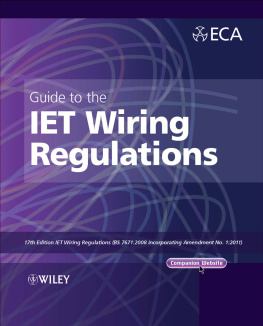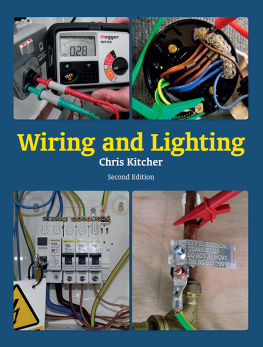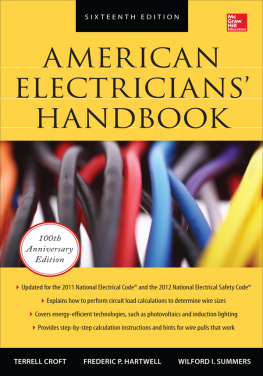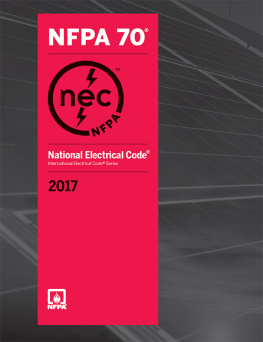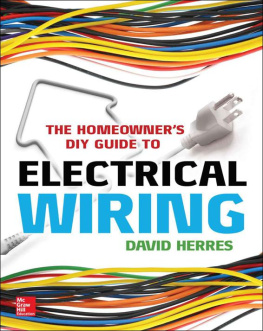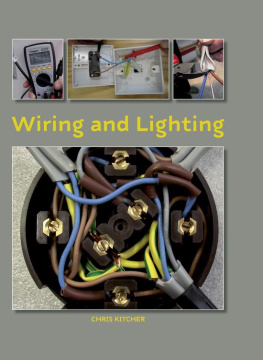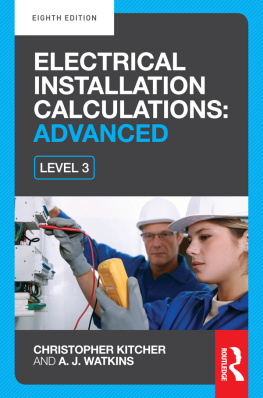DEWALT
ELECTRICAL
CODE REFERENCE
2014 Edition
Written by
Daniel Sandefur
and
American Contractors Exam Services

Published by


DEWALT Electrical Code Reference 2014, Third Edition: Based on the National Electrical Code including the NEC 2014
Daniel Sandefur and American Contractors Exam Services
Executive Director of Professional Technology and Trades Training Solutions:
Taryn McKenzie
Product Manager:
Vanessa Myers
Associate Content Developer:
Jennifer Wheaton
Director of Marketing:
Beth A. Lutz
Senior Marketing Manager:
Marissa Lavigna
Senior Director, Production:
Wendy Troeger
Director, Production:
Patty Stephan
Senior Art Director:
Benjamin Gleeksman
Senior Content Project Management:
Stacey Lamodi
2015, 2012, 2008 Cengage Learning
WCN: 01-100-101
ALL RIGHTS RESERVED. No part of this work covered by the copyright herein may be reproduced, transmitted, stored, or used in any form or by any means graphic, electronic, or mechanical, including but not limited to photocopying, recording, scanning, digitizing, taping, Web distribution, information networks, or information storage and retrieval systems, except as permitted under Section 107 or 108 of the 1976 United States Copyright Act, without the prior written permission of the publisher.
For product information and
technology assistance, contact us at Cengage Learning
Customer & Sales Support, 1-800-354-9706
For permission to use material from this text or product,
submit all requests online at cengage.com/permissions
Further permissions questions can be emailed to
permissionrequest@cengage.com
Library of Congress Control Number: 2014940163
ISBN: 978-1-305-39505-3
Cengage Learning
20 Channel Center Street
Boston, MA 02210
USA
Cengage Learning is a leading provider of customized learning solutions with office locations around the globe, including Singapore, the United Kingdom, Australia, Mexico, Brazil, and Japan. Locate your local office at: international.cengage.com/region
Cengage Learning products are represented in Canada by Nelson Education, Ltd.
Visit us at www.ConstructionEdge.cengage.com
For more learning solutions, please visit our corporate website at
www.cengage.com
Notice to the Reader
Cengage Learning, DEWALT and the International Code Council do not warrant or guarantee any of the products described herein or perform any independent analysis in connection with any of the product information contained herein. Cengage Learning, DEWALT and the ICC do not assume, and expressly disclaim, any obligation to obtain and include information other than that provided to it by the manufacturer. The reader is expressly warned to consider and adopt all safety precautions that might be indicated by the activities described herein and to avoid all potential hazards. By following the instructions contained herein, the reader willingly assumes all risks in connection with such instructions. Cengage Learning, DEWALT and the ICC make no representations or warranties of any kind, including but not limited to, the warranties of fitness for particular purpose or merchantability, nor are any such representations implied with respect to the material set forth herein, and Cengage Learning, DEWALT and the ICC take no responsibility with respect to such material. Cengage Learning, DEWALT and the ICC shall not be liable for any special, consequential or exemplary damages resulting, in whole or part, from the readers use of, or reliance upon, this material.
DEWALT and GUARANTEED TOUGH are registered trademarks of the DEWALT Industrial Tool Co., used under license.
All rights reserved. The yellow and black color scheme is a trademark for DEWALT Power Tools and Accessories.
Trademark Licensee: Cengage Learning, 20 Channel Center Street, Boston, MA 02210; Tel.: 800-354-9706;
www.ConstructionEdge.cengage.com. A licensee of DEWALT Industrial Tools.
Printed in the United States of America
Print Number: 01 Print Year: 2014
A Note to the Reader
The DEWALT Electrical Code Reference is not a formal code interpretation and is not intended to replace the code. You will need a copy of the 2011 and 2014 NFPA 70 National Electrical Code (NEC ) to check all references given in this book.
This book is designed to help you understand some, but not all, phases of electrical installations. The guidelines illustrated in this book are not the only way to install the systems shown. Local codes sometimes have exceptions or regulations that are enforced along with the 2011 and 2014 NEC.
Anyone working on an electrical project should contact their local building inspection department, office of planning and zoning, and/or department of permits in order to learn which codes are being used and how they will affect their project. Both the 2011 and 2014 NEC Code are copyrighted work owned by the National Fire Protection Association.
NFPA 70 is a trademark of the National Fire Protection Association.
NFPA, National Fire Protection Association, National Electrical Code, and NEC are registered trademarks of the National Fire Protection Association.
For more information on the National Fire Protection Association or the National Electrical Code, please contact:
Phone: 1-800-344-3555
Web: www.nfpa.org
Section M1305.1.3
Excerpted from the 2012 International Residential Code;
Copyright 2011.
Washington, D.C.: International Code Council.
Reproduced with permission. All rights reserved. www.ICCSAFE.org
CONTENTS
GENERAL TERMS AND DEFINITIONS
AFCI (Arc-Fault Circuit Interrupter)
A device intended to provide protection from the effects of arc faults by recognizing characteristics unique to arcing and by functioning to de-energize the circuit when an arc fault is detected. Example: Arc faults may occur when loose connections or faulty appliances are introduced into a circuit. This type of circuit protection is intended to prevent fires caused by these types of faults.
Branch Circuit
The circuit conductors between the final overcurrent device protecting the circuit and the outlet(s).
Current
A measurement of the rate of flow of electricity through a conductor, measured in amps.
Device
A unit of an electrical system, other than a conductor, that is intended to carry or control but not utilize electricity (i.e., switches, thermostats).
Equipment Grounding Conductor
A conductor used to ground electrical equipment. Commonly referred to in the electrical field as the ground. These conductors are usually identified by green insulation or bare. The NEC uses the term equipment grounding conductor for these conductors.
Feeder
The circuit conductors between the service equipment or other power supply and the final overcurrent device. Subpanels are commonly located throughout buildings and the circuits feeding these panels are called feeders. Simply put, the conductors between 2 overcurrent devices are called feeder conductors.


